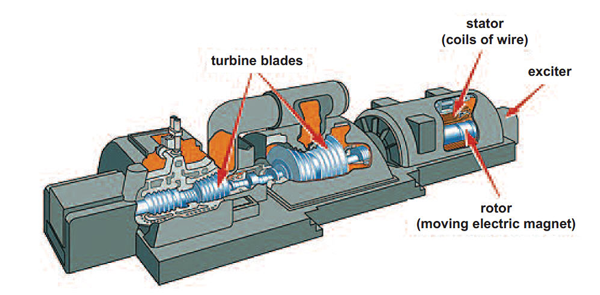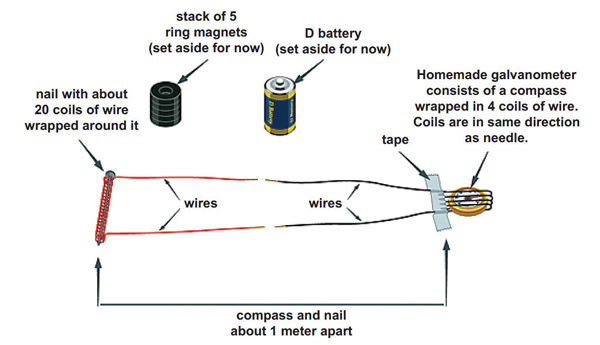Electromagnetic Advanced Experiment
Background
Your local utility delivers electricity to your home, but where does the utility company get the electricity? They make it in a generating plant by changing mechanical energy (motion) into electrical energy. Giant coils of wire are moved past powerful magnets—then presto! The pull of the magnets causes the electrons in the metal wire to move. It’s not magic. It’s electromagnetic induction.
In this activity, you’ll use a stack of magnets to generate current in a wire. You’ll use a homemade galvanometer (a compass wrapped in wire) to detect the current.

Materials
- 1 compass
- 1 iron nail
- 1 pkg. ring magnets, stacked together
- 2 pcs. 18-22 gauge wire, each 50 inches long with ends stripped
- 1 D battery
- electrical tape
- wire cutters

Steps
- Set up the equipment as shown, but do not connect the wires yet. Tightly wrap the iron nail in as many coils as will fit in a single layer, leaving approximately the same amount of wire free at each end. Set the wrapped nail aside.Next, using the middle of the remaining piece of wire, wrap the compass in four coils of wire, leaving the long ends free. Make sure the coils are parallel with the compass needle. This is your galvanometer. A galvanometer is a device used to detect and measure current.
Tape the compass to a flat surface, and make sure the needle can spin freely. Be sure the nail and the compass (galvanometer) are at least three feet apart throughout the entire experiment. (This is important, because you don’t want the magnets to affect the magnetic compass needle.)
- Touch the ends of the galvanometer wire to the positive and negative ends of the D battery and watch what happens.
Questions
- Is the current produced by the battery AC or DC? (Hint: Note how the needle in your galvanometer moved.)
- Set the battery aside. Now connect the ends of the galvanometer wire to the ends of the wire wrapped around the nail. (Remember to keep the nail and the galvanometer three feet apart.) Move the stack of magnets back and forth over the nail. What happens to the needle in your galvanometer? What can you conclude from this?
- Did you produce AC current or DC current when you moved the magnet back and forth over the coils?
- What do you think would happen if you used a stronger magnet? More magnets? More coils of wire? Try it and see.

